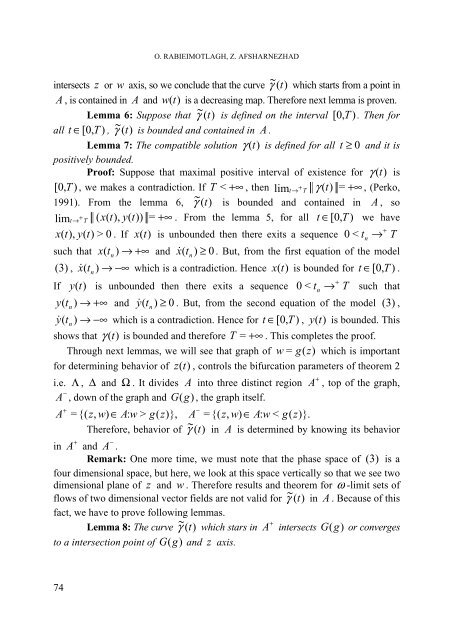biologia - Studia
biologia - Studia
biologia - Studia
You also want an ePaper? Increase the reach of your titles
YUMPU automatically turns print PDFs into web optimized ePapers that Google loves.
O. RABIEIMOTLAGH, Z. AFSHARNEZHAD<br />
intersects z or w axis, so we conclude that the curve<br />
~ γ ( t ) which starts from a point in<br />
A , is contained in A and w (t)<br />
is a decreasing map. Therefore next lemma is proven.<br />
Lemma 6: Suppose that<br />
~ γ ( t ) is defined on the interval [0,<br />
T ) . Then for<br />
all t ∈ [0,<br />
T ) ,<br />
~ γ ( t ) is bounded and contained in A .<br />
Lemma 7: The compatible solution γ (t)<br />
is defined for all t ≥ 0 and it is<br />
positively bounded.<br />
Proof: Suppose that maximal positive interval of existence for γ (t)<br />
is<br />
[0,<br />
T ) , we makes a contradiction. If T < +∞ , then lim t→ +<br />
T | γ ( t)<br />
|<br />
= +∞ , (Perko,<br />
1991). From the lemma 6,<br />
~ γ ( t ) is bounded and contained in A , so<br />
lim t →<br />
+<br />
T | ( x(<br />
t),<br />
y(<br />
t))<br />
|<br />
= +∞ . From the lemma 5, for all t ∈ [0,<br />
T ) we have<br />
+<br />
x ( t),<br />
y(<br />
t)<br />
> 0 . If x (t)<br />
is unbounded then there exits a sequence 0 < t n<br />
→ T<br />
such that x ( t n<br />
) → +∞ and x& ( ) ≥ 0 . But, from the first equation of the model<br />
t n<br />
(3) , x& ( t n<br />
) → −∞ which is a contradiction. Hence x (t)<br />
is bounded for t ∈ [0,<br />
T ) .<br />
+<br />
If y (t)<br />
is unbounded then there exits a sequence 0 < t n<br />
→ T such that<br />
y ( t n<br />
) → +∞ and y& ( ) ≥ 0 . But, from the second equation of the model (3) ,<br />
t n<br />
y& ( t n<br />
) → −∞ which is a contradiction. Hence for t ∈ [0,<br />
T ) , y (t)<br />
is bounded. This<br />
shows that γ (t)<br />
is bounded and therefore T = +∞ . This completes the proof.<br />
Through next lemmas, we will see that graph of w = g(<br />
z)<br />
which is important<br />
for determining behavior of z (t)<br />
, controls the bifurcation parameters of theorem 2<br />
i.e. Λ , ∆ and Ω . It divides A into three distinct region<br />
−<br />
A , down of the graph and G (g)<br />
, the graph itself.<br />
A<br />
+<br />
+<br />
A , top of the graph,<br />
−<br />
= {( z,<br />
w)<br />
∈ A:<br />
w > g(<br />
z)},<br />
A = {( z,<br />
w)<br />
∈ A:<br />
w < g(<br />
z)}.<br />
Therefore, behavior of<br />
~ γ ( t ) in A is determined by knowing its behavior<br />
+ −<br />
in A and A .<br />
Remark: One more time, we must note that the phase space of (3) is a<br />
four dimensional space, but here, we look at this space vertically so that we see two<br />
dimensional plane of z and w . Therefore results and theorem for ω -limit sets of<br />
flows of two dimensional vector fields are not valid for<br />
~ γ ( t ) in A . Because of this<br />
fact, we have to prove following lemmas.<br />
Lemma 8: The curve<br />
~ γ ( t ) which stars in<br />
+<br />
A intersects G (g)<br />
or converges<br />
to a intersection point of G (g)<br />
and z axis.<br />
74
















